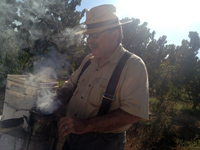
I recently had the pleasure of spending a sunny morning out in the Orchard with Alan Hawkins, one of our beekeepers. Clad in bee gear, it was a thrill to hear the hum of hundreds of bees buzzing around us. After Alan smoked the hives to mask the alert pheromone produced by bees and to calm them, I was able to sneak a peek into each of the hives and gain a glimpse into the mysterious lives of honeybees.
Alan is a retired high school teacher who became fascinated with bees at an early age. As a boy he remembers watching honeybees buzz in and out of a tree and realized that though he had watched for a long time, time had passed very quickly.
Today Alan cares for 27 hives (or bee boxes) at FHF. His honey harvest season is done for this year, but he is busy checking on the health of the hives in order to get the bees ready for bed, so to speak. To winterize, he is checking the hives for mite infestation, assessing the overall health of the colony, removing layers of boxes to help concentrate the hive, providing ventilation for condensation so they have water over the winter, and making sure the queens are still alive and well.
Right now the bees are busy themselves. They are out collecting as much nectar as possible to store up for the winter when little will be blooming and colder temperatures and wet weather will discourage the bees from leaving the hives. During the later half of Oct., Nov. and Dec., the colonies will spend more time in their hives keeping warm. The bees will live in a cluster to keep the temperature of the hive at 95 degrees so the colony can incubate its brood. In the winter the colony population is at its lowest with about 12,000 bees per hive.
Unlike many commercial beekeepers that harvest all the honey from the hives in the Fall and feed the bees diluted sugar water through the winter, Alan makes sure to leave ample honey in the hive for them to eat through winter.
January 1st marks the beginning of a new year for bees too. Honeybees respond to sunlight and with the increased light that January brings, the queen will begin to lay more eggs. Spring in CA begins in February when the blossoms appear. When our trees begin to flower, the bees start to emerge from their hives in search of nectar. Spring is a time when the bees eat as much as they can from the orchard blossoms, the wildflowers, and the habitat plantings throughout the orchard. They are busy eating and repopulating the colony by making more baby bees. The combs from which the baby bees emerge will act as storage combs for the nectar they collect. At a colonies height in late May, the population will increase to about 60,000 bees per hive!
Like our orchard crew, Alan is busy harvesting during the summer months with peek harvest in late July. From the 27 hives at Frog Hollow, he harvests about 2,000 lbs of honey per year on a good year. All of Alan’s honey is hand processed. He cuts the combs from the frames of the hive and then using his hands and a large potato masher, he crushes the cones before filtering the honey into jars. He believes (and so do we) that this provides superior flavor to the honey because the honey is imbued with more of the essence of the comb. Alan just dropped off some of this summers harvest to the farm on Thursday, so add some on to your box today to enjoy the bees summer work!

 Follow
Follow
